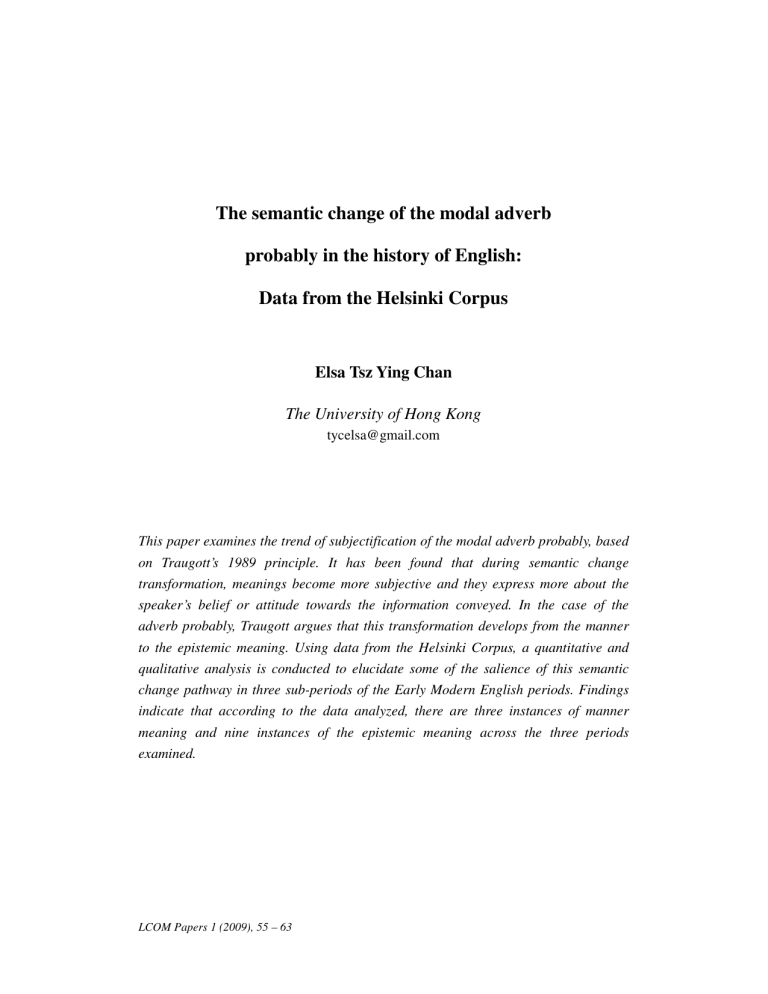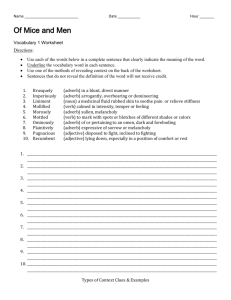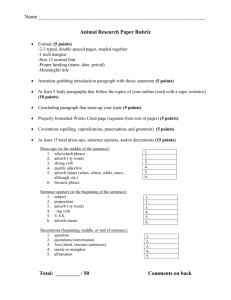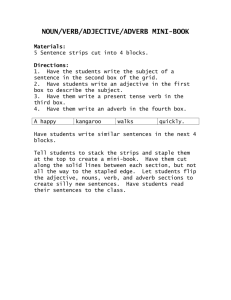The semantic change of the modal adverb probably in the history of

The semantic change of the modal adverb probably in the history of English:
Data from the Helsinki Corpus
Elsa Tsz Ying Chan
The University of Hong Kong
tycelsa@gmail.com
This paper examines the trend of subjectification of the modal adverb probably, based on Traugott’s 1989 principle. It has been found that during semantic change transformation, meanings become more subjective and they express more about the speaker’s belief or attitude towards the information conveyed. In the case of the adverb probably, Traugott argues that this transformation develops from the manner to the epistemic meaning. Using data from the Helsinki Corpus, a quantitative and qualitative analysis is conducted to elucidate some of the salience of this semantic change pathway in three sub-periods of the Early Modern English periods. Findings indicate that according to the data analyzed, there are three instances of manner meaning and nine instances of the epistemic meaning across the three periods examined.
LCOM Papers 1 (2009), 55 – 63
56 Elsa Tsz Ying Chan
1. Introduction
The notion of subjectification in semantic change has been examined by a number of linguists (e.g. Langacker, 1985; Palmer, 1986; Traugott, 1989). It has been found that in this pathway of semantic change, meanings become more subjective and they express more about the speaker’s belief or attitude towards the information conveyed.
For example, in the case of modal adverbs such as probably , they develop from the manner meaning to the epistemic meaning, from expressing predications in the external world to revealing the speaker’s subjective attitude towards the proposition
(Traugott, 1989).
This paper is a study on the trend of subjectification of the modal adverb probably based on Traugott’s (1989) principle. It uses the data from the Helsinki Corpus to conduct a quantitative and qualitative analysis on the semantic development of probably . In the following, I will first offer some background information on
Traugott’s (1989) research and the history of the adverb probably , which is then followed by the methodology section. After that, some of the findings will be analyzed and discussed.
2. Background and research question
There are various kinds of semantic change. In particular, this paper focuses on the tendency of subjectification. As suggested by Traugott (1989), in this path of semantic change, there is some tendency for the words to acquire a more subjective meaning and reveal the speaker’s subjective belief or attitude towards what is expressed.
Traugott (1989) demonstrates this principle with examples of some modal auxiliaries such as must and will , assertive speech act verbs such as assume and suggest , and modal adverbs such as probably and evidently . The examples used in this paper are drawn from studies done by other linguists (e.g. Venezky and Healey, 1980; Mitchell,
1985; Visser, 1963 – 1973), and from corpus dictionaries such as the Oxford English
Dictionary (OED) and the Middle English Dictionary (MED).
In Traugott’s (1989) paper, the development of the modal auxiliaries has been discussed in depth. Although the semantic change of the speech act verbs was only examined briefly in this paper, it has been investigated in a more detailed manner in
The semantic change of the modal adverb probably 57 some of his other works (Traugott, 1986; Traugott and Dasher, 1987). On the other hand, the change in the meaning of the modal adverbs is only reported based on
Hanson’s (1987) principle, with a few examples from the OED and MED. Moreover, no quantitative data on the different meanings of the adverbs has been presented.
Therefore, it will be interesting to extend this line of finding by conducting a quantitative and qualitative analysis on the different meanings of the modal adverbs in different periods in history using data other than the OED and MED. Particularly, this research focuses on the semantic change of the modal adverb probably as reported in
Traugott’s (1989) paper. It aims to study whether the meaning of the modal adverb probably changes from manner to epistemic in the history of English.
The modal adverb probably originally came from the French word probablement in
1370s ( Oxford English Dictionary , 2008). According to Traugott (1989), there are two kinds of meanings of the adverb probably . The first one is the manner meaning. In this sense, probably means “plausibly, in a way that is likely to prove true” (Traugott,
1989: 46); it states some predications that are based on the external world. The second meaning is the epistemic meaning, which expresses the speaker’s mental attitude towards the information conveyed. These two kinds of meanings reported in Traugott
(1989) are similar to the ones that appear in the Oxford English Dictionary (2008), in which the first meaning of probably refers to “in a way that commends itself to one's reason for acceptance or belief; in a way that seems likely to prove true; with likelihood (though not with certainty); plausibly”, while the second meaning is used to qualify the information expressed and it refers to “almost certainly; as far as one knows or can tell; in all probability; most likely”.
Traugott (1989) argues that the manner meaning of probably precedes the epistemic meaning in the history of English. He reports an OED example in the early 1500s to show the manner meaning of the adverb and an OED example in the 17th century to show the epistemic meaning. This notion of the semantic change is consistent with the one suggested by the Oxford English Dictionary (2008), which states that the first meaning emerged in 1443 and is now rarely used while the second meaning was first documented in the 1600’s. This semantic development shows a trend of subjectification, as the adverb originally had the manner meaning, a kind of meaning that is more based on the external world, and this meaning later changed to the epistemic meaning which shows the speaker’s subjective attitude towards the proposition (Traugott, 1989).
58 Elsa Tsz Ying Chan
This trend of subjectification in the semantic development of the adverb probably will be examined in the next section using data other than the OED.
3. Methodology
The data in this study were collected from the Helsinki Corpus of English Texts . The
Helsinki Corpus is a diachronic corpus which contains texts in the Old English period
(OE: year 850 – 1150), Middle English period (ME: year 1150 – 1500) and the Early
Modern English period (EModE: year 1500 – 1710) (Kytö, 1996). The texts in the OE period consist of 413,250 words, those in the ME period consist of 608,570 words, and those in the EModE period consist of 551,000 words (Kytö, 1996). Since the adverb probably started to exist in the English language in the 15th century, only the data in the ME and EModE parts of the corpus are relevant to this study.
The WordSmith Tool was used in this study to generate data from the Helsinki Corpus .
First, two wordlists were generated, one for the ME subcorpus and the other for the
EModE subcorpus. The frequency of occurrence of the adverb probably was then taken directly from the wordlists, as the word probably only has had this spelling pattern throughout history and does not have other forms. After that, the concordance lines of each instance of the adverb were examined to determine the different meanings of probably , and frequency data was generated with reference to the sub-periods in the EModE part of the corpus. Lastly, a qualitative analysis with the examples from the corpus was also conducted.
4. Findings and discussion
4.1 Quantitative analysis
From the wordlists generated by the WordSmith Tool , the adverb probably appears two times in the ME part of the corpus, and thirteen times in the EModE part of the corpus respectively. However, the two instances which appear in the ME part, and the one instance in the EModE part are discarded because they are not part of the original texts but are the editors’ comments on the texts. This means that in the Helsinki
Corpus , the actual frequencies of occurrence of the adverb probably in the ME
The semantic change of the modal adverb probably 59 subcorpus and the EModE subcorpus are 0 and 12 respectively. The normalized frequency of the occurrence of probably in the EModE part is 21.7 per million words
1
.
Since all the instances of the word probably appear to occur in the EModE period, there is a need to further look into the sub-periods of this part of the corpus in order to examine the change in the meaning of the word. According to Kytö (1996), the three sub-periods in the EModE part of the Helsinki Corpus are: period 1 (1500 – 1570), period 2 (1570 – 1640) and period 3 (1640 – 1710). The adverb probably appears in period 1 only once, and the remaining 11 instances all occur in period 3. After examining the concordances of each instance and determining the meanings of probably , the frequency data can be presented as follows:
Meanings
Manner
Epistemic
Total
Frequency in the sub-periods of EModE
Frequency in period 1
Frequency in period 2
Frequency in period 3
1
0
1
0
0
0
2
9
11
As shown in the above table, in period 1, the only instance of probably has a manner meaning. On the other hand, the majority of the instances of probably (nine) have an epistemic meaning while the remaining two have a manner meaning.
4.2 Qualitative analysis
4.2.1 Probably in period 1
The only instance of probably that appears in EModE period 1 is:
(P1)…which Statute hath these Wordes touching and concerning the Treasons that I am indited and arraigned of; that is to saye, Whosoeuer doth compasse or imagine the Death of the King, or leuie War against the King in his Realm, or being adherent to the Kings Enimies within this Realme, or elsewhere, or be thereof probably attained by open Deede by People of their Condition, shall be adjudged a Traytor. ( Helsinki Corpus : cetri1)
1
Total no. of hits of probably / total no. of words in EModE part * 1 million = 12/551000*1000000 =
21.7
60 Elsa Tsz Ying Chan
In example (P1), the adverb probably means “plausibly or believably”. The sentence can be rephrased as “the one who…is believably to have been detected in an offence
(an open act) by People of their Condition will be judged as a Traitor”. It does not express the speaker’s subjective opinion, but rather states a predication.
4.2.2 Probably in period 3
In period 3, the manner meaning still exists. An example of this is:
(P3a)…considering the mighty assistance of God’s Grace, which he is ready to afford us, and the unspeakable satisfaction and delight which is to be had in the doing of our duty, nothing can be easier: Nothing will give us that pleasure, while we live; nothing can minister that true and solid comfort to us, when we come to die: There is probably no such way for a man to be happy in this World; to be sure, there is no way but this to escape the intolerable and endless miseries of anther World. ( Helsinki Corpus : ceserm3a)
Similarly, the adverb probably here can be replaced by “plausibly”. It occurs in the context of some religious instructions. It does not express the speaker’s attitude.
However, there are more instances of the epistemic meaning in period 3. For example:
(P3b) The principles of Religion and the doctrines of the Holy Scriptures are terrible enemies to wicked men, they are continually flying in their faces and galling their consciences: And this is that which makes them kick against
Religion and spurn at the doctrines of that holy Book. And this may probably be one reason why many men, who are observed to be sufficiently dull in other matters, yet can talk prophanely and speak against Religion with some kind of salt and smartness, because Religion is the thing that frets them…( Helsinki
Corpus : ceserm3a)
(P3c) I hereafter discover, having first set down somewhat how to remedy that defect in reading English, with which the Grammar-Schooles are very much troubled, especially, where there is not a good Petty-Schoole to discharge that work afore-hand. And before I proceed further, I will expresse my minde in the two next chapters touching the erecting of a Petty-Schoole, and how it may probably flourish by good. ( Helsinki Corpus : ceeud3b)
The semantic change of the modal adverb probably 61
In the examples (P3b) and (P3c), the adverb probably means “likely”, revealing the attitude towards what is being expressed. The modal verb may in these two examples as well as the clause “I will expresse my minde” in (P3c) signal that the proposition is the speaker’s opinion rather than something in the external world. The collocation
“may probably”, which does not appear in the instances of the manner meaning, may also be an indication of the change of the adverb to a more subjective meaning.
Considering the contexts in which the adverb occurs, the only instance of probably in period 1 and the majority of instances in period 3 appear in more formal contexts such as trial proceedings, sermons and education treatises. However, some instances in period 3 are also found to be in a less formal setting such as in private letters. As
Traugott (1989) has suggested, the semantic change from a nonepistemic meaning to an epistemic meaning happens because the word has been spread to a greater variety of contexts. From the data in the Helsinki Corpus , it appears that the relatively formal contexts in which the adverb probably occurs may have started to spread to the less formal ones, leading to the process of semantic change.
There appears to be one point that is consistent with this notion and may be therefore worth mentioning here. The genre in which the adverb occurs may affect how it is used. The instance in period 1 is from trial proceedings, and the two instances with the manner meaning in period 3 are both from sermons. In these contexts, the speaker may seldom express his or her own attitude towards the proposition. As a result, the number of times that the adverb occurs in these texts may affect the total frequency of the adverb with a manner meaning. This may imply that the manner meaning of probably may be associated with more formal contexts. With the spread of contexts of use as mentioned above, the epistemic meaning may have developed and started to appear in more informal settings as well.
5. Conclusion
Based on Traugott (1989), this study examines the trend of subjectification of the modal adverb probably mainly in the three sub-periods of the Early Modern English period. Traugott (1989) has stated that the meaning of probably changes from manner to epistemic, thus showing a trend of subjectification. From the data extracted from the Helsinki Corpus , there is an instance of the manner meaning in the earliest period
62 Elsa Tsz Ying Chan of EModE, whereas most of the instances in the last period of EModE are of the epistemic meaning. However, due to the limited size of the data, a conclusion about the manner-to-epistemic semantic change cannot be made at this point. Yet, there appears to be only one instance of the adverb probably in period 1 of the EModE, no instances in period 2, and only eleven instances in period 3; therefore this data may not be very representative of the use of the word in each period.
Nevertheless, this study still manages to supply some additional examples for the subjectification principle of the development of the adverb probably . In future studies, it may be more advisable to investigate the semantic change of probably with reference to more examples in other corpora. Moreover, a larger amount of sample data should be considered in order to obtain more conclusive results. Lastly, the role that genre texts may play in the trend of subjectification of probably may also merit further investigation.
References
Hanson, K. 1987. On subjectivity and the history of epistemic expressions in English.
Chicago Linguistic Society , 23, 132 – 147.
Kytö, M. 1996. Manual to the diachronic part of the Helsinki Corpus of English Texts:
Coding conventions and lists of source texts . Helsinki: The University of
Helsinki.
Langacker, R. W. 1985. Observations and speculations on subjectivity. In J. Haiman
(ed), Iconicity in Syntax . Amsterdam: Benjamins, 109 – 150.
Mitchell, B. 1985. Old English Syntax (vol. 2) . Oxford: Clarendon Press.
Oxford English Dictionary . 2008. London: Oxford University Press. Retrieved on 1
May 2008 from http://dictionary.oed.com/
Palmer, F. R. 1986. Mood and modality . Cambridge: Cambridge University Press.
Traugott, E. C. 1986. English speech act verbs: A historical perspective. In L. R.
Waugh, & S. Rudy (eds), New Vistas in Grammar: Invariance and Variation.
Proceedings of the Second International Roman Jakobson Conference , New York
University, 10 – 13 Oct 1985. Amsterdam: J. Benjamins.
Traugott, E. C. 1989. On the rise of epistemic meanings in English: An example of subjectification in semantic change. Language , 65(1), 31 – 55.
The semantic change of the modal adverb probably 63
Traugott, E. C., & Dasher, R. 1987. On the historical relation between mental and speech act verbs in English and Japanese. In A. G. Ramat, O. Carruba, & G.
Bernini (eds), Papers from the seventh international conference on historical linguistics.
Amsterdam: Benjamins, 561 – 573.
Venezky, R. L., & Healey, A. D. 1980. A Microfiche Concordance of Old English:
Dictionary of Old English Project . Centre for Medieval Studies: University of
Toronto.
Visser, F. T. 1963 – 1973. An Historical Syntax of the English Language (vol. 3) .
Leiden: Brill.









